In his book The Art of Perennial Gardening author Patrick Lima says "blue can do no wrong in matters of associations. Put it with yellow, apricot, buff and peach; put it with pinks warm or cool; next to red is fine; it's lovely with white, mauve, magenta, silver." Make your own partnership choices or follow any of the associations suggested below for a lovely and harmonious picture.
"Blue flowers are in such demand, are such certain sellers, that nurserymen have to stretch the interpretation of the word to snapping point." Christopher Lloyd in Color For Adventurous Gardeners
You will have to decide what constitutes a "true" blue for yourself. Read the information about the perennials below, use Google Images to check some of them out for yourself and only then will you be able to choose how blue you wish your blue plants to be.
* Watch for the animated hummingbird and butterfly with the plants that attract them. *
The deer icon indicates plants that deer are not usually attracted to.
   The best time and method to propagate plants can be found on our image-intensive PROPAGATION page.
To help your plants grow their best, check out our FERTILIZATION page.
To create your own plant partnerships based on tried and true color theory, check out our GARDEN COLOR page.
To see if a particular plant is on this page press Ctrl+F, type in the name, then click the Find button.
The best time and method to propagate plants can be found on our image-intensive PROPAGATION page.
To help your plants grow their best, check out our FERTILIZATION page.
To create your own plant partnerships based on tried and true color theory, check out our GARDEN COLOR page.
To see if a particular plant is on this page press Ctrl+F, type in the name, then click the Find button.
IRIS
 Iris x germanica - Bearded Iris
Iris x germanica - Bearded Iris
The bearded iris species has many blue-flowered cultivars. Unlike the Siberian Irises below, these need full sun to flourish. Unlike the water Iris below, these like it hot and dry. Give them those conditions and they will reward you generously with plenty of blooms in a huge variety of colours including blue. Before long you'll have lots to share with friends and neighbours.
Iris x germanica 'Night Edition': Bearded Iris, blue-spotted white standards, blue falls, yellow beard
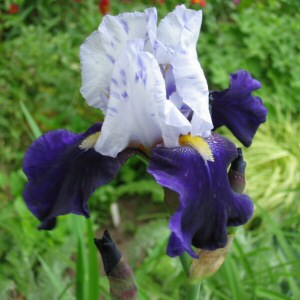
Note: as the image above shows, this cultivar needs no help from nearby companions to create an impression
Iris sibirica - Siberian Iris
Among all the Iris species, the Siberian Iris may have the most blue forms. Easier to grow and more trouble-free than others, they prefer full sun, but will tolerate part shade, especially in warmer zones. Rich, moist soil that is moderately acidic (5.2-6.4) suits them just fine. Leave clumps alone until you notice there are significantly fewer blooms. Only then should you divide them, preferably in the fall but also possible in the spring. New clumps may take two or three years to become established and again bloom profusely.
This species is frequently misspelled. The English adjective is Siberian, while the specific epithet, the botanical Latin equivalent of the English adjective, is sibirica.
Iris sibirica: Siberian Iris
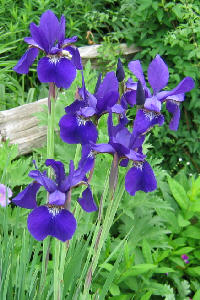
in full sun with: Campanula carpatica, Paeonia lactiflora, Salvia nemorosa
with other early-bloomers: Digitalis purpurea, Bergenia, hardy Geranium spp
with other early-bloomers for part shade to shade: Alchemilla mollis, Astilbe (Japanese), Campanula trachelium
with Ornamental grasses: Miscanthus sinensis
Here are some Siberian Iris cultivars to watch for. Google them all to see how blue they really are.
Iris sibirica 'Blue Reverie': EM, 35", light blue flowers, white signals, wide ruffled styles
Iris sibirica 'Borbeleta': EL, 34", clear dark blue, dappled light blue with purple undertones
Iris sibirica 'Cleve Dodge': M, 30", velvety midnight blue
Iris sibirica 'Coronation Anthem': medium blue, 32x18-24", vigorous and floriferous
Iris sibirica 'Dewful': M, 36", huge deep blue flowers
Iris sibirica 'Early Bluebird': EM, 32", clear blue
Iris sibirica 'Forrest McCord': intense dark blue with a golden-white blaze, 36"x22"
Iris sibirica 'Harpswell Hallelujah': blue-violet, 24-36"x9-12", late mid-season bloomer
Iris sibirica 'Harpswell Haze': ML, 35", light pastel blue standards with true-blue falls, tetraploid
Iris sibirica 'Kingfisher Blue': M, 32", light violet-blue with lighter standards
Iris sibirica 'Natick': LM, 40", clear sky blue
Iris sibirica 'Navy Brass': ML, 30", intense navy blue with gold blazes
Iris sibirica 'Orville Fay': ML, 36", medium blue
Iris sibirica 'Sally Kerlin': 27, EM-L ; frilled, light blue with a pure white blaze
Iris sibirica 'Silver Edge': 24-30"x18-24", medium-blue self, falls have fine silver edge, EM-LM
Iris sibirica 'Sky Wings': 28", M, very pretty light blue
Iris sibirica 'Super Ego': 30", LM, very pale blue standards, darker blue falls fading to white at edges
Iris sibirica 'Swank': 32", M, clear, crisp blue
Iris versicolor - Flag Iris
Bearded and Siberian Irises are not the only species with blue flowers. If you have a water garden, you may grow the water-loving species below.
Iris versicolor: Flag Water Iris, blue
with: other moisture-loving Iris spp. i.e. Iris pseudacorus (yellow Flag Iris)
If it's ideas you need to help you choose other colours to enhance your garden, follow the links below.
Iris for edging
bulbous Iris forms
orange Iris
purple Iris
red Iris
white Iris
yellow Iris
Iris with variegated foliage
LAVANDULA
  A sub-shrub, Lavender is fragrant and will draw bees to your garden. It's up to you whether you consider that a bonus or a drawback. Showy flower spikes are a definite bonus.
Lavandula angustifolia: English Lavender, deep blue
A sub-shrub, Lavender is fragrant and will draw bees to your garden. It's up to you whether you consider that a bonus or a drawback. Showy flower spikes are a definite bonus.
Lavandula angustifolia: English Lavender, deep blue
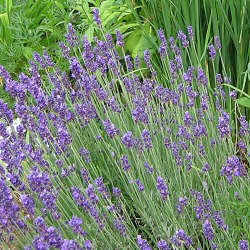
formerly: Lavandula vera
where: mid-border or along a flag-stone path
with: Allium including A. schoenoprasum (Common Chives)
with: Achillea filipendulina 'Gold Plate' or 'Parker's Variety'
with: Arabis caucasica, Asclepias tuberosa, Coreopsis spp.
with: Clematis alpina
with: shrub Rosa, Geranium, Stachys, Solidago canadensis
with: roses, in gardens or arrangements
There are other forms of Lavender and information on their care and maintenance at the link below.
purple Lavender forms
silver foliage Lavender forms
LINUM
 Flax blooms in late spring to early summer in a lovely soft shade of blue. Arching stems bear wide open flowers that add a touch of class wherever they pop up - and they will self-seed but are easily pulled out if they do so where you don't want them. If cut back after blooming, this perennial may produce more sporadic bloom thereafter. The best part is that the each flower, once it is finished, simply drops off the plant onto the ground. No dead-heading needed here.
Linum perenne: Flax, sky-blue
Flax blooms in late spring to early summer in a lovely soft shade of blue. Arching stems bear wide open flowers that add a touch of class wherever they pop up - and they will self-seed but are easily pulled out if they do so where you don't want them. If cut back after blooming, this perennial may produce more sporadic bloom thereafter. The best part is that the each flower, once it is finished, simply drops off the plant onto the ground. No dead-heading needed here.
Linum perenne: Flax, sky-blue
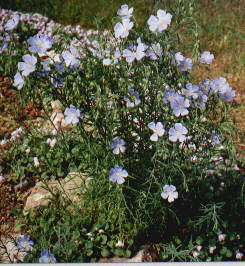
generally with: other wildflowers, gray or silver-foliaged plants
with: Achillea millefolium 'Cerise Queen', Iris (to lighten them up)
with: Achillea x 'Moonshine', Paeonia
beside: Astilbe
in front of: Aquilegia x McKana Giants
combined behind : Iris pallida pallida (synonym: Iris pallida dalmatica) & Viola 'Huntercombe Purple'
combined with: Iris x germanica (cream & blue), Achillea x 'Moonshine', Dictamnus albus (white ),
Paeonia (pale pink) & Veronica
with: Helianthus multiflorus 'Flore-Pleno', Allium, Lupinus, Papaver nudicaule 'Champagne Bubbles',
beside: Geranium sanguineum striatum, Helictotrichon sempervirens, Erysimum 'Bowles' Mauve'
in front of: Lunaria annua (underplanted with Anemone x hybrida 'Honorine Jobert')
in front of: Romneya coulteri (California tree poppy underplanted with Myosotis & Scilla sibirica)
combined with: salmon-pink Papaver orientale
combined with: Tulipa (white or yellow) & Phlox paniculata 'Miss Lingard' (white)
Linum perenne 'Sapphire': Flax, dwarf, compact, 10-12"
where: as edger, in rock gardens
If you have tried only the blue Flax, you may want to go for a different effect with the forms at the links below.
white Flax
yellow Flax
MERTENSIA
Mertensia, also known as Bluebells and Cowslips, goes dormant after it has finished its bloom, but at its peak, you can't ask for a nicer blue effect for sun or shade in consistently moist soil. This spring-blooming wildflower also has foliage in basal rosettes that serves to set off the colour of the nodding flowers to advantage.
Mertensia virginica: Virginia Bluebells, April-May, 12-24", sapphire
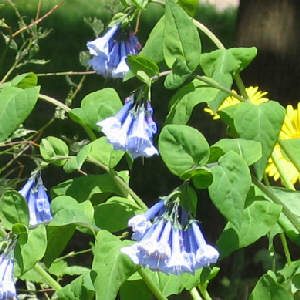
where: woodland garden, along woodland path
under: shrubs and trees
with spring bulbs: Narcissus, species Tulipa, Scilla
with wildflowers: Claytonia virginica, Sanguinaria canadensis, Trillium
with: Aquilegia, Phlox divaricata, Asarum canadense, Dicentra
with: Narcissus, esp. pink 'Mrs. R. O. Backhouse' or yellow Narcissus
to co-bloom with: Anemone sylvestris & Iris cristata
before: Acidanthera (annual)
interplanted with foliage plants: winter-dormant ferns, later-emerging Hosta, (to fill bare spots during dormancy)
Follow the link below for more information about this wonderful woodland plant.
Mertensia in shade
MONARDA
   The shaggy flower heads of the Bee Balms come in many colours, including a few bluish ones including the one below. Note that it is referred to as blue-purple but it has been included here nonetheless. Divide your plants often to keep them healthy. Good air circulation in your garden will help avoid powdery mildew outbreaks.
Monarda 'Blue Stocking': blue-purple
The shaggy flower heads of the Bee Balms come in many colours, including a few bluish ones including the one below. Note that it is referred to as blue-purple but it has been included here nonetheless. Divide your plants often to keep them healthy. Good air circulation in your garden will help avoid powdery mildew outbreaks.
Monarda 'Blue Stocking': blue-purple

combined with: Lilium 'Mount Everest', Monarda 'Marshall's Delight' & Echinacea purpurea 'White Swan
For a wealth of information about different Bee Balms and their care, follow the links below.
butterfly-friendly Bee Balm
pink Bee Balm
red Bee Balm
white Bee Balm
NEPETA
 Catmint is a genus that does contain useful blue flowers. Partner them with lots of brighter companions for best effect. Trim them back after the first flush for more bloom later on.
Nepeta x faassenii: Catmint, bright blue
Nepeta sibirica 'Blue Beauty': Catmint
For more detail about the genus Nepeta and what to plant with it, visit the link below.
Catmints as edgers
Catmints with silver foliage
Catmint is a genus that does contain useful blue flowers. Partner them with lots of brighter companions for best effect. Trim them back after the first flush for more bloom later on.
Nepeta x faassenii: Catmint, bright blue
Nepeta sibirica 'Blue Beauty': Catmint
For more detail about the genus Nepeta and what to plant with it, visit the link below.
Catmints as edgers
Catmints with silver foliage
PEROVSKIA
 Chosen Perennial Plant of the Year for 1995 by the Perennial Plant Association, this perennial has gray-green foliage and tiny lavender-blue flowers that appear in a haze in mid-summer. Sorry - true blue it is not. But wonderful in any case in well-drained soil. Cut this one back in spring as you would with Butterfly Bush.
Perovskia atriplicifolia: Russian Sage
Chosen Perennial Plant of the Year for 1995 by the Perennial Plant Association, this perennial has gray-green foliage and tiny lavender-blue flowers that appear in a haze in mid-summer. Sorry - true blue it is not. But wonderful in any case in well-drained soil. Cut this one back in spring as you would with Butterfly Bush.
Perovskia atriplicifolia: Russian Sage
now: Perovskia x superba
with yellow flowers: Coreopsis verticillata 'Moonbeam'
with: pink, deep blue and/or purple flowers
with: Achillea including 'Summer Pastels', Campanula lactiflora 'Loddon Anna' (a soft pink),
Campanula persicifolia (purple), Echinacea purpurea, Echinops ritro, Eryngium, Filipendula rubra, Lavatera thuringiaca, Liatris, Lilium 'Trance' (a pink Oriental Lily with a trace of blue), Lychnis (red & orange flowered forms) including Lychnis x arkwrightii, Lychnis chalcedonica, Malva (pink), Papaver orientale, Phlox paniculata, Platycodon grandiflorum, Salvia argentea, Sidalcea malviflora 'Party Girl'
behind: Veronica austriaca 'Crater Lake Blue'
with: late-blooming Rudbeckia including 'Goldsturm' or 'Marmalade' & other late-blooming daisies,
with: Rudbeckia laciniata 'Goldquelle'
in shade with: Dodecatheon meadia, Aconitum x bicolor, Polemonium caeruleum
with white flowers: Phlox paniculata 'Mt. Fujiyama'
with: Boltonia asteroides
with Ornamental Grasses: Helictotrichon sempervirens, Miscanthus sinensis 'Silberfeder'
combined with: Knautia macedonica, Scabiosa caucasica 'Alba' & Coreopsis verticillata 'Moonbeam'
combined with: Phlox paniculata 'Mt. Fujiyama' (white) & Coreopsis verticillata 'Moonbeam'
combined with: Rudbeckia fulgida var. sullivantii 'Goldsturm' & annual Salvia farinacea 'Victoria'
combined with: Rudbeckia nitida 'Autumn Glory', 'Golden Glow' or 'Autumn Sun' & Solidago 'Peter Pan'
combined with: Calamintha, Gypsophila paniculata 'Perfecta' & Phlox paniculata
behind: Sedum spectabile 'Carmen'
beside: Lychnis coronaria 'Alba', Eryngium bourgatii, Rudbeckia forms
You can find more about this shrubby-looking perennial at the link below.
Russian Sage with silver foliage
PHLOX
Nowhere is the use of the word "blue" to describe a flower more misleading than in the Phlox genus. You probably won't ever find anything that is a "true blue" shade. Others come close but may have mauve or lilac, even pink or purple tones mixed in. Your best bets are in the Phlox divaricata, Phlox stolonifera and Phlox subulata species below.
If you want to use Google Images to check out the following, that might help you choose the ones most appropriate for your gardens.
Phlox divaricata 'Laphamii': crystal blue
Phlox divaricata 'London Grove Blue': pale blue, fragrant, 10-12"x12"
Phlox divaricata 'May Breeze': very pale blue, 12-15"x12"
Phlox stolonifera 'Blue Ridge': a perfect blue, cloud-like ground-cover, 6-10"x24"
Phlox subulata 'Emerald Blue': pale medium-blue
Follow the links below for more partnership ideas and information about various Phlox species and cultivars.
Phlox to attract Butterflies
Phlox for edging
orange Phlox
pink Phlox
red Phlox
Phlox for shade
white Phlox
Phlox with variegated foliage
PLATYCODON
 From the Greek platys meaning "broad" and kodon meaning "bell" comes the genus commonly called Bellflower. Seen in the border around this page, as well as in the images at the top of the page and directly below, it has broad yet shallow, 3" wide, bell-shaped blooms. These open from balloon-like buds that can be popped open by squeezing with your fingers should you be so inclined. The genus has only one species as indicated below, although there are many cultivars and flower colours available. Some are referred to as blue, but most have purple tints, tones or hues. There are cultivars in white and pink as well.
Division is seldom necessary, but can be done in spring or early fall, either to propagate or to transplant. Be sure to dig the entire root ball deeply and avoid damaging fleshy roots. Always use a sharp knife to cut crowns into sections. You can increase your plants as well by removing and replanting rooted shoots at the base of an established clump. And most cultivars come true from seed.
Platycodon grandiflorus var. Mariesii Blue: dwarf, 12-18", purple-blue flowers
From the Greek platys meaning "broad" and kodon meaning "bell" comes the genus commonly called Bellflower. Seen in the border around this page, as well as in the images at the top of the page and directly below, it has broad yet shallow, 3" wide, bell-shaped blooms. These open from balloon-like buds that can be popped open by squeezing with your fingers should you be so inclined. The genus has only one species as indicated below, although there are many cultivars and flower colours available. Some are referred to as blue, but most have purple tints, tones or hues. There are cultivars in white and pink as well.
Division is seldom necessary, but can be done in spring or early fall, either to propagate or to transplant. Be sure to dig the entire root ball deeply and avoid damaging fleshy roots. Always use a sharp knife to cut crowns into sections. You can increase your plants as well by removing and replanting rooted shoots at the base of an established clump. And most cultivars come true from seed.
Platycodon grandiflorus var. Mariesii Blue: dwarf, 12-18", purple-blue flowers
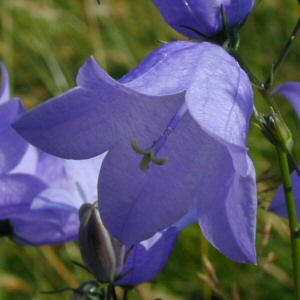
synonym: Platycodon grandiflorus 'Mariesii'
synonym: Platycodon grandiflorus ssp. mariesii
what: dwarf variety; outstanding, reliable, durable; flowers 2" across on graceful, wandlike stems
use foliage to: set off bright blue or pink flowers
with bulbs: Allium, Lilium
with: Achillea filipendulina, Achillea 'Moonshine', Asclepias tuberosa, Gypsophila, Salvia x superba, Monarda didyma
with: Phlox paniculata, Stachys byzantina, Artemisia spp.
with: Ornamental Grasses
in front of: pink Rosa rugosa
Platycodon grandiflorus 'Miss Tilley': Balloon Flower, the largest flower size, Zone 7
named for: prominent, award-winning flower breeder - Tilly Holtrop
where: containers, border front
Platycodon grandiflorus 'Sentimental Blue': dwarf Balloon Flower, 15" tall, lilac-blue flowers
where: containers, window boxes, front of perennial border
with: Alchemilla mollis, gray Artemisia, Nepeta x faassenii
Information about Balloon Flower and companionship suggestions can be found on the pages below.
pink Balloon Flower
purple Balloon Flower
white Balloon Flower
the wonder of the Balloon Flower
POLEMONIUM
 The flowers of plants in the Jacob's Ladder genus are generally cup- or saucer-shaped, appearing on succulent stems. This fibrous-rooted perennial prefers evenly moist, humus-rich soil that is well-drained. Growing best in full sun to partial shade, it works well planted in masses as well as under shrubs or airy flowering trees.
Blooming in late spring to early summer, flowers of various species and cultivars can be blue, lavender-blue, pink, white or even yellow. Good for wild or woodland gardens or for cutting, plants will flower for many weeks, especially in cooler climates. The main drawback in this very hardy genus is its intolerance of hot, humid climates.
Species and their cultivars with the word "blue" in the name are listed below, but there is no guarantee that flowers will be a true blue. Follow the link to Google Images and type in the names below and judge for yourself how close they come to a blue shade to suit your gardens.
Polemonium reptans 'Blue Pearl': blue flowers slightly darker than those of the species
Polemonium viscosum 'Blue Whirl': to 24", lavender-blue flowers on tall stems, an excellent shade plant
Plant partners for the forms above can be found at the links to our other pages that showcase this genus.
purple Jacob's Ladder
variegated foliage Jacob's Ladder
white Jacob's Ladder
Jacob's Ladder in shade
The flowers of plants in the Jacob's Ladder genus are generally cup- or saucer-shaped, appearing on succulent stems. This fibrous-rooted perennial prefers evenly moist, humus-rich soil that is well-drained. Growing best in full sun to partial shade, it works well planted in masses as well as under shrubs or airy flowering trees.
Blooming in late spring to early summer, flowers of various species and cultivars can be blue, lavender-blue, pink, white or even yellow. Good for wild or woodland gardens or for cutting, plants will flower for many weeks, especially in cooler climates. The main drawback in this very hardy genus is its intolerance of hot, humid climates.
Species and their cultivars with the word "blue" in the name are listed below, but there is no guarantee that flowers will be a true blue. Follow the link to Google Images and type in the names below and judge for yourself how close they come to a blue shade to suit your gardens.
Polemonium reptans 'Blue Pearl': blue flowers slightly darker than those of the species
Polemonium viscosum 'Blue Whirl': to 24", lavender-blue flowers on tall stems, an excellent shade plant
Plant partners for the forms above can be found at the links to our other pages that showcase this genus.
purple Jacob's Ladder
variegated foliage Jacob's Ladder
white Jacob's Ladder
Jacob's Ladder in shade
SISYRINCHIUM
 Blue-Eyed Grass isn't really a grass at all. Rather it is a member of the Iris family, producing tufts of flat, grass-like foliage. Flowers produced in early summer are starry and, you guessed it, blue. Preferring moist, average to rich soil in sun or part shade, these should be divided, when necessary, just after flowering.
Sisyrinchium angustifolium: 6-10" tall, steel-blue star-shaped flowers
Blue-Eyed Grass isn't really a grass at all. Rather it is a member of the Iris family, producing tufts of flat, grass-like foliage. Flowers produced in early summer are starry and, you guessed it, blue. Preferring moist, average to rich soil in sun or part shade, these should be divided, when necessary, just after flowering.
Sisyrinchium angustifolium: 6-10" tall, steel-blue star-shaped flowers

uses: in meadow plantings, as a short-statured garden accent
STOKESIA
  Stokes' Aster, named after Jonathan Stokes, an English physician and botanist, is a welcome sight amid all of late summer's bright oranges and yellows. It has been said that its beautiful flower "combines the precision of a thistle with the softness of an aster". Capturing the true colours of the flower however is simply impossible, making the overall impression it creates difficult to describe. Is it lavender? Is it blue? Are there pinkish tones? Plant your own and decide on the answer to those questions.
A drought-resistant perennial, it is happy in either full sun or light shade and in moist, well-drained, sandy soil. Cutting stems back to the base will encourage rebloom on this lovely native North American wildflower. There are pink and white forms as well. A definite bonus is that the plants will attract butterflies and are deer- and rabbit-resistant.
Stokesia laevis: Stokes' Aster, 12-24"x12"
Stokes' Aster, named after Jonathan Stokes, an English physician and botanist, is a welcome sight amid all of late summer's bright oranges and yellows. It has been said that its beautiful flower "combines the precision of a thistle with the softness of an aster". Capturing the true colours of the flower however is simply impossible, making the overall impression it creates difficult to describe. Is it lavender? Is it blue? Are there pinkish tones? Plant your own and decide on the answer to those questions.
A drought-resistant perennial, it is happy in either full sun or light shade and in moist, well-drained, sandy soil. Cutting stems back to the base will encourage rebloom on this lovely native North American wildflower. There are pink and white forms as well. A definite bonus is that the plants will attract butterflies and are deer- and rabbit-resistant.
Stokesia laevis: Stokes' Aster, 12-24"x12"
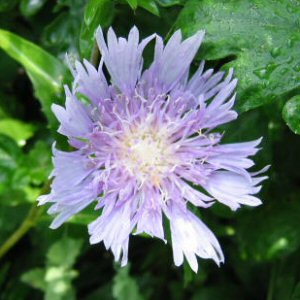
note the shaggy, cornflower-like flowerheads, that can reach 3-4" across
with: Verbena, Artemisia spp.
in front of: Achillea 'Red Beauty'
with other Stokesia cultivars:
- 'Blue Danube', large 4" lavender blue flowers
- 'Blue Moon', deep blue
- 'Bluestone', small, to 10", clear blue
- 'Wyoming', the darkest blue flowerheads of all
Stokesia 'Blue Danube': soft lavender-blue, 12-23"x12-18"
combined with: Gentiana 'Benichidori', Geranium 'Wargrave Pink' & Calamintha nepetoides (White Beautiful Mint)
with: Monarda didyma
VINCA
Periwinkle, sometimes also called Myrtle, is a well-loved groundcover perennial for shady spots. Greater Periwinkle, 6-10" tall, hardy to Zone 6 has pale blue flowers. Common Periwinkle, only 4-6" tall, hardy to Zone 4, has lavender-blue or white flowers. The word "Blue" in a cultivar name is no guarantee that the flowers will be blue. In most cases, flowers have purple tones.
There are web sites with much more information about this genus than we can provide here. Bookmark us before you leave so you can get back to us soon.
- Peekskill Nurseries has good images of different cultivars and ideas for their use
- Paghat's Garden is jam-packed with wonderful reading about this and many other perennials
- Perry's Perennials with details about both species and their cultivars, including foliage descriptions
Vinca minor 'Bowles Blue': 4-6"x24-36" is said to have light blue flowers
Vinca minor 'Bowles Variety': light blue flowers, may rebloom throughout gardening season, synonym: V. m. 'La Grave'
Vinca minor 'Dart's Blue': blue, spreads out from the crown rather than rooting along stems
any of the above with: Athyrium nipponicum 'Pictum', Heuchera, Salvia nemorosa, Hosta, Carex elata,
TO RETURN TO THE FIRST PAGE OF BLUE PERENNIALS & THEIR COMPANIONS, FOLLOW THE LINK BELOW.
All of our own Gardens By The Bay pages can be accessed by clicking on the links below.
HOME
GARDEN POETRY |
GARDEN POETRY MUSE
GEORGIAN BAY VIEW
BOTANICAL LATIN - BASICS
COLOR THEORY
THE GARDENS
CORNER GARDEN CONSTRUCTION |
CORNER GARDEN PLANTING |
LONG GARDEN
EAST GARDEN |
HOSTA GARDEN |
NORTH GARDEN |
WINTER GARDENS
PLANT PARTNERSHIPS
BLUE PERENNIALS Aconitum -
Geranium |
Iris - Vinca
BULBS Allium - Hyacinthus |
Narcissus only |
Tulipa only |
Minor Bulbs
BUTTERFLY MAGNETS Anaphalis - Hemerocallis |
Liatris - Veronicastrum
 DAYLILIES Spider & Unusual Form DAYLILIES Spider & Unusual Form EDGERS Arabis - Iris |
Nepeta - Veronica
FOLIAGE PERENNIALS
Alchemilla - Tanacetum
HOSTA Hosta - all
HUMMINGBIRD-FRIENDLY PERENNIALS Alcea - Salvia
ORANGE PERENNIALS Achillea - Tulipa
ORNAMENTAL GRASSES Acorus - Imperata |
Miscanthus - Spodiopogon
PINK PERENNIALS Achillea - Lilium |
Lychnis - Veronica
PURPLE PERENNIALS Aconitum - Liatris |
Polemonium - Veronica
RED PERENNIALS Achillea - Veronica
SHADE PERENNIALS Aegopodium - Erythronium |
Ferns - Polemonium |
Polygonatum - Vinca
SILVER FOLIAGE PERENNIALS
Achillea - Cerastium
|
Cornus - Limonium
|
Lunaria - Veronica
SIMPLY SPECIAL PERENNIALS Acanthus - Saxifraga
WHITE PERENNIALS Achillea - Iris |
Kalimeris - Yucca
YELLOW PERENNIALS Achillea - Hypericum |
Inula - Verbascum
VARIEGATED-FOLIAGE PERENNIALS Acorus - Erythronium |
Hakonechloa - Lysimachia |
Miscanthus - Yucca
PLANT PROFILES
Dianthus 'Tiny Rubies' |
Geranium |
Geum coccineum |
Kerria japonica |
Knautia macedonica
Paeonia tenuifolia |
Papaver somniferum |
Rudbeckia |
Salvia 'East Friesland'
Trollius |
Veronica 'Sunny Border Blue'
PROPAGATION
DIVISION - SPRING ONLY |
DIVISION - FALL ONLY |
DIVISION - SPRING OR FALL |
DO NOT DIVIDE
FERTILIZATION
EDGERS Arabis - Iris |
Nepeta - Veronica
FOLIAGE PERENNIALS
Alchemilla - Tanacetum
HOSTA Hosta - all
HUMMINGBIRD-FRIENDLY PERENNIALS Alcea - Salvia
ORANGE PERENNIALS Achillea - Tulipa
ORNAMENTAL GRASSES Acorus - Imperata |
Miscanthus - Spodiopogon
PINK PERENNIALS Achillea - Lilium |
Lychnis - Veronica
PURPLE PERENNIALS Aconitum - Liatris |
Polemonium - Veronica
RED PERENNIALS Achillea - Veronica
SHADE PERENNIALS Aegopodium - Erythronium |
Ferns - Polemonium |
Polygonatum - Vinca
SILVER FOLIAGE PERENNIALS
Achillea - Cerastium
|
Cornus - Limonium
|
Lunaria - Veronica
SIMPLY SPECIAL PERENNIALS Acanthus - Saxifraga
WHITE PERENNIALS Achillea - Iris |
Kalimeris - Yucca
YELLOW PERENNIALS Achillea - Hypericum |
Inula - Verbascum
VARIEGATED-FOLIAGE PERENNIALS Acorus - Erythronium |
Hakonechloa - Lysimachia |
Miscanthus - Yucca
PLANT PROFILES
Dianthus 'Tiny Rubies' |
Geranium |
Geum coccineum |
Kerria japonica |
Knautia macedonica
Paeonia tenuifolia |
Papaver somniferum |
Rudbeckia |
Salvia 'East Friesland'
Trollius |
Veronica 'Sunny Border Blue'
PROPAGATION
DIVISION - SPRING ONLY |
DIVISION - FALL ONLY |
DIVISION - SPRING OR FALL |
DO NOT DIVIDE
FERTILIZATION
BULBS |
ORNAMENTAL GRASSES |
PERENNIALS |
SHRUBS |
VINES
LINKS
GARDENS |
LOCAL GARDENS |
BOTANICAL TERMINOLOGY
GARDENING BOOKS |
NON-GARDENING
HOME
|